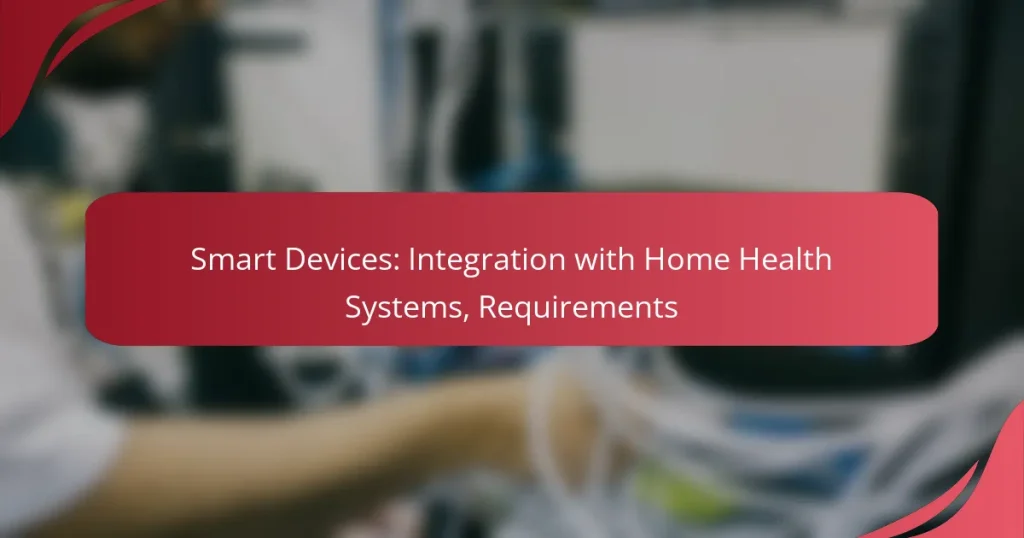Smart devices play a crucial role in enhancing home health systems by connecting various health monitoring tools and applications, which streamlines patient care and improves communication. To ensure effective integration, these devices must meet specific technical standards and security measures, facilitating seamless data exchange and protection. By incorporating wearables, voice assistants, and smart lighting, home health systems can significantly enhance health monitoring and create supportive environments for well-being.
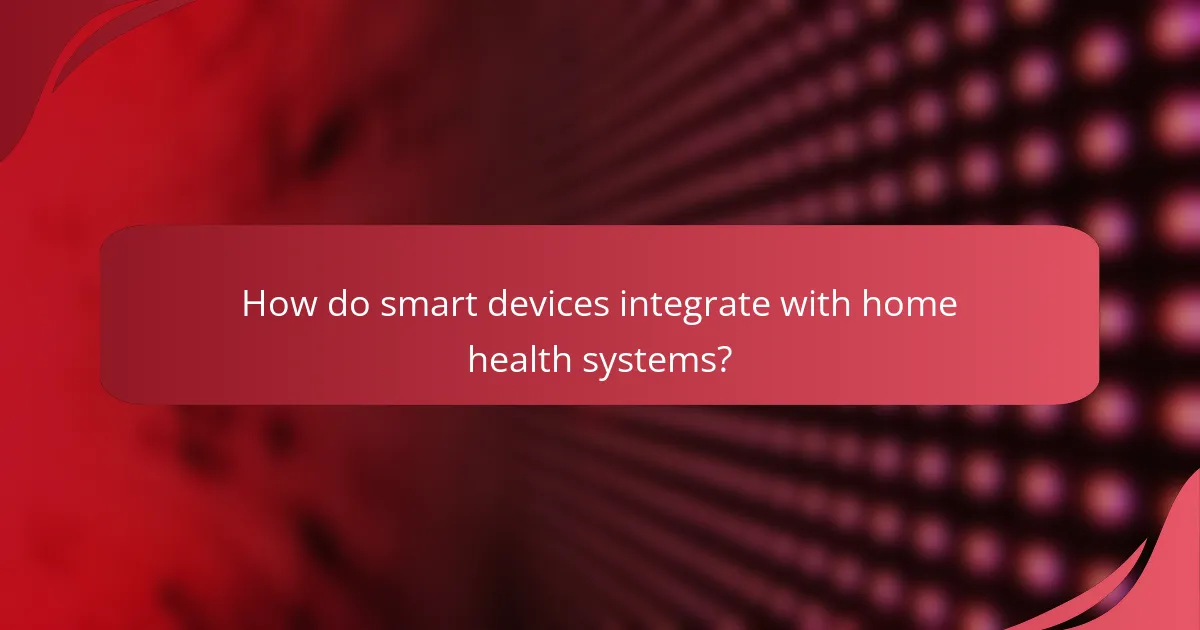
How do smart devices integrate with home health systems?
Smart devices integrate with home health systems by connecting various health monitoring tools and applications to streamline patient care. This integration enhances data collection, improves communication between devices, and supports remote health management.
Integration with wearable health monitors
Wearable health monitors, such as fitness trackers and smartwatches, collect real-time health data like heart rate, activity levels, and sleep patterns. These devices typically sync with home health systems via Bluetooth or Wi-Fi, allowing for continuous monitoring and data analysis.
When selecting wearables, consider compatibility with existing health systems and ensure they meet relevant health standards. Popular options include devices from brands like Fitbit, Apple, and Garmin, which often provide APIs for easier integration.
Compatibility with smart home hubs
Smart home hubs serve as central points for managing connected devices, including health-related gadgets. Devices like Amazon Echo or Google Nest can integrate with health systems to facilitate voice commands and automate health monitoring tasks.
To ensure compatibility, check if the smart home hub supports the specific health devices you intend to use. This can enhance user experience by allowing seamless control and monitoring through a single interface.
Data sharing with telehealth platforms
Data sharing between smart devices and telehealth platforms is crucial for effective remote healthcare. This process allows healthcare providers to access patient data in real-time, enabling timely interventions and personalized care plans.
When using telehealth services, ensure that the smart devices comply with data privacy regulations, such as HIPAA in the United States. Look for platforms that offer secure data transmission and robust encryption to protect sensitive health information.

What are the requirements for integration?
Integration of smart devices with home health systems requires adherence to specific technical standards, security measures, and compatibility with existing infrastructure. These requirements ensure seamless communication, data protection, and effective functionality within the healthcare environment.
Wi-Fi connectivity standards
Wi-Fi connectivity is crucial for the integration of smart devices in home health systems. Devices should support the latest Wi-Fi standards, such as Wi-Fi 5 (802.11ac) or Wi-Fi 6 (802.11ax), to ensure high-speed data transfer and reliable connections. This is particularly important for applications that require real-time monitoring and data transmission.
When selecting devices, consider the range and coverage of your Wi-Fi network. Devices should ideally operate on both 2.4 GHz and 5 GHz bands to optimize performance in various home layouts. Regularly updating your router firmware can also enhance connectivity and security.
Data security protocols
Data security is paramount when integrating smart devices into home health systems. Devices must implement strong encryption protocols, such as WPA3 for Wi-Fi connections, to protect sensitive health information from unauthorized access. Additionally, using secure communication methods like HTTPS for data transmission is essential.
Regular software updates and patches are necessary to address vulnerabilities. Users should also consider enabling two-factor authentication where available to add an extra layer of security to their devices and accounts.
Interoperability with existing systems
Interoperability is vital for ensuring that new smart devices can communicate effectively with existing home health systems. Devices should comply with established healthcare standards like HL7 or FHIR, which facilitate data exchange between different systems and applications. This compatibility helps in creating a cohesive health monitoring environment.
Before purchasing new devices, assess their compatibility with your current health management systems. Conducting a pilot test with a few devices can help identify any integration issues early on, allowing for adjustments before full deployment.

Which smart devices are best for home health systems?
Smart devices that integrate well with home health systems include wearables, voice assistants, and smart lighting. These devices enhance health monitoring, provide convenience through voice commands, and create supportive environments for well-being.
Fitbit Charge 5 for health tracking
The Fitbit Charge 5 is a popular choice for health tracking, offering features like heart rate monitoring, sleep analysis, and activity tracking. It provides insights into daily activity levels and can help users set and achieve fitness goals.
When using the Fitbit Charge 5, consider its compatibility with other health apps and devices. This integration allows for a more comprehensive view of your health data. Regularly syncing the device with your smartphone can ensure you stay updated on your progress.
Amazon Echo for voice commands
The Amazon Echo serves as a versatile voice assistant that can control various smart devices in your home health system. Users can set reminders for medication, ask for health tips, or control compatible devices hands-free.
To maximize the benefits of the Amazon Echo, explore its compatibility with health-related skills and routines. For example, you can create a morning routine that includes reminders for exercise or hydration. Ensure your Echo is updated to access the latest features and improvements.
Philips Hue for ambient health lighting
Philips Hue smart lighting can significantly enhance your home health environment by adjusting lighting based on your needs. Soft, warm lighting can promote relaxation, while brighter settings can energize your space during the day.
When implementing Philips Hue, consider using schedules or routines to automate lighting changes. For instance, dimming lights in the evening can signal your body to wind down. Ensure your lighting setup is compatible with your existing smart home system for seamless control.
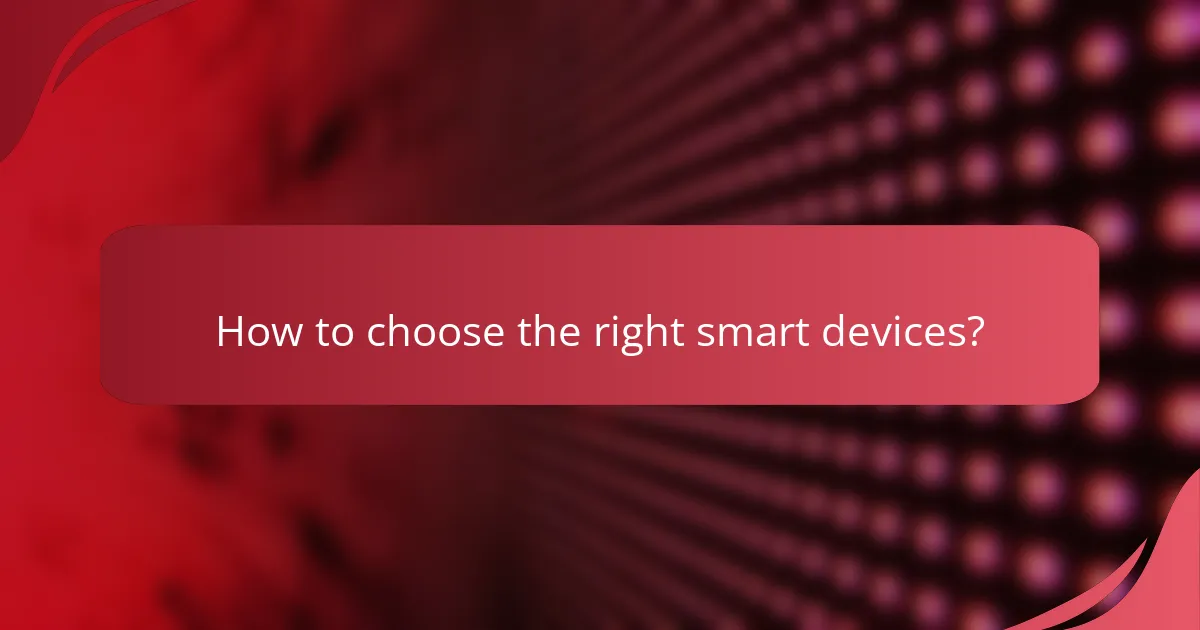
How to choose the right smart devices?
Choosing the right smart devices for home health systems involves understanding user needs, ensuring compatibility with existing technology, and considering budget constraints. Prioritizing these factors will help in selecting devices that enhance health management effectively.
Assessing user needs and preferences
Start by identifying the specific health needs of the users, such as monitoring chronic conditions, medication reminders, or fitness tracking. Engaging users in discussions about their preferences can reveal which features are most important to them.
Consider factors like ease of use, accessibility, and the type of data users want to track. For instance, older adults may prioritize devices with larger displays and voice control, while tech-savvy individuals might prefer more advanced functionalities.
Evaluating device compatibility
Check if the smart devices can integrate with existing home health systems and other smart devices. Compatibility with platforms like Apple Health, Google Fit, or specific health apps is crucial for seamless data sharing.
Review the technical specifications and standards of the devices, such as Bluetooth or Wi-Fi capabilities. Ensuring that devices can communicate effectively with each other will enhance their overall functionality and user experience.
Considering budget and pricing
Establish a budget for smart devices, keeping in mind that prices can vary widely based on features and brand reputation. Basic health monitoring devices may cost around $50 to $150, while more advanced systems can exceed $500.
Look for devices that offer good value for money, balancing features with affordability. Consider long-term costs, such as subscription fees for premium services or additional accessories that may be required for full functionality.
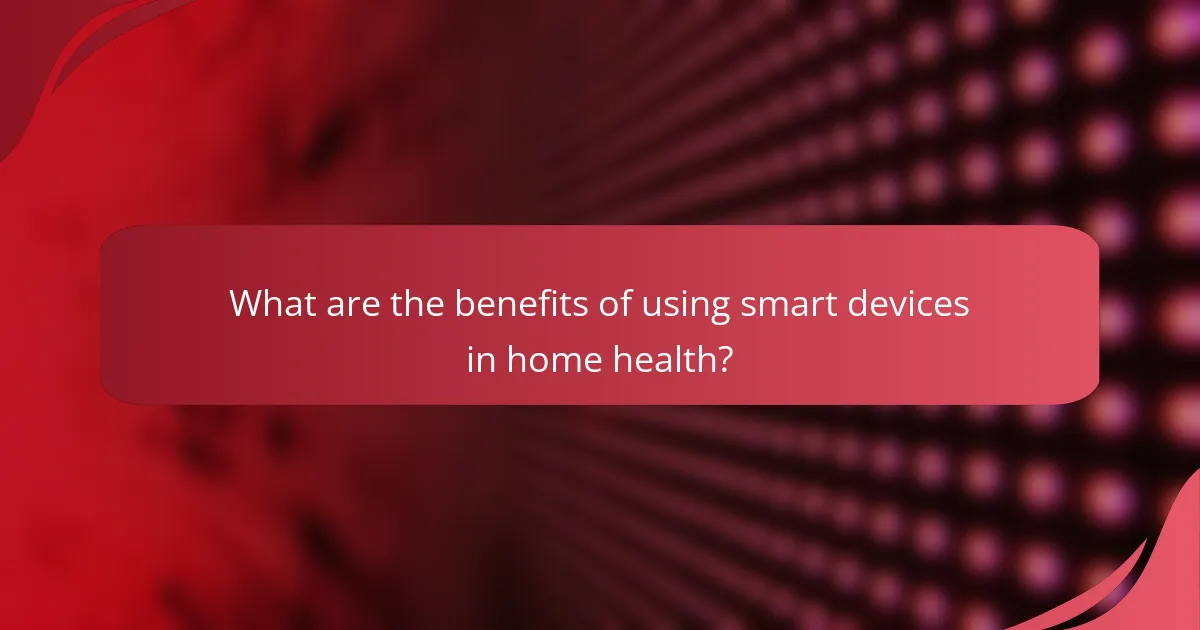
What are the benefits of using smart devices in home health?
Smart devices in home health provide significant advantages, including real-time monitoring, improved communication with healthcare providers, and enhanced patient engagement. These benefits lead to better health outcomes and a more proactive approach to managing health conditions.
Improved patient monitoring
Smart devices enable continuous monitoring of vital signs, such as heart rate, blood pressure, and glucose levels. This real-time data allows for timely interventions, reducing the risk of complications and hospitalizations.
Devices like wearable fitness trackers and smart blood pressure monitors can automatically send data to healthcare providers, ensuring that any concerning trends are quickly addressed. Patients can also receive alerts for medication reminders or abnormal readings, promoting adherence to treatment plans.
Enhanced communication with healthcare providers
Smart devices facilitate seamless communication between patients and their healthcare teams. Through apps and connected platforms, patients can share their health data directly with providers, allowing for more informed decision-making.
Telehealth services can be integrated with smart devices, enabling virtual consultations that save time and reduce travel costs. This is particularly beneficial for patients in rural areas or those with mobility challenges.
Increased patient engagement
Smart devices empower patients to take an active role in their health management. By providing easy access to personal health data, patients can better understand their conditions and make informed lifestyle choices.
Many devices offer gamification features, such as challenges or rewards for meeting health goals, which can motivate patients to stay engaged. Educational resources and community support through connected platforms further enhance this engagement, fostering a sense of accountability and support.
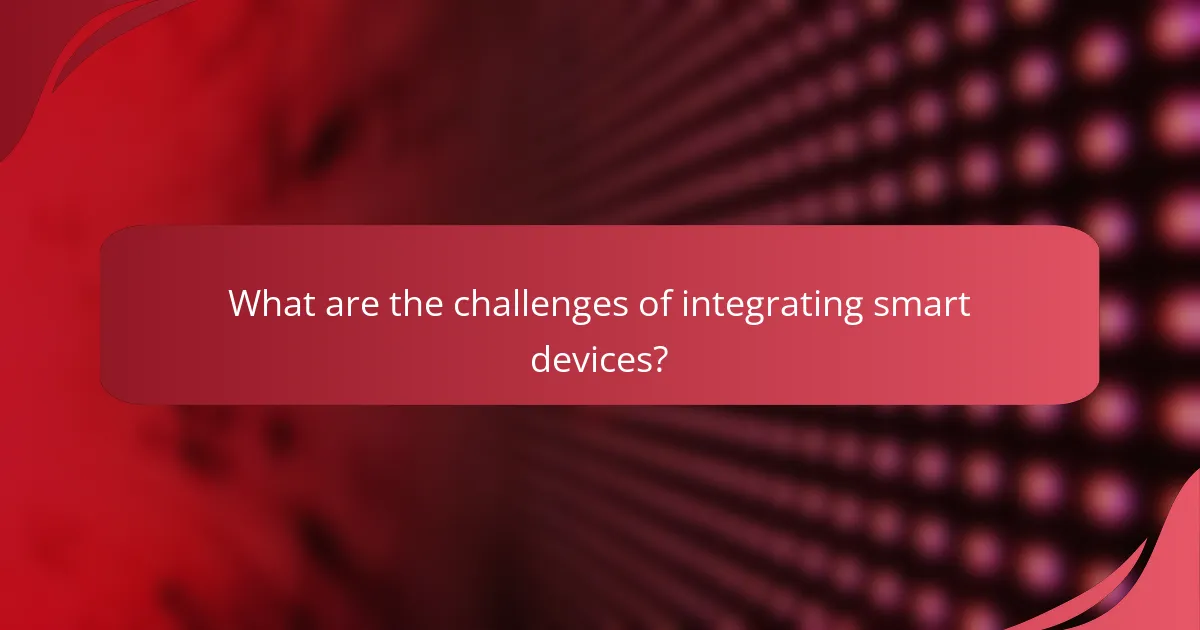
What are the challenges of integrating smart devices?
Integrating smart devices into home health systems presents several challenges, primarily related to compatibility, security, and user experience. These issues can complicate the setup process and hinder effective communication between devices.
Technical difficulties in setup
Setting up smart devices often involves navigating various technical difficulties, such as ensuring compatibility with existing systems and networks. Many devices require specific protocols or standards, which can lead to integration issues if not properly aligned.
Users may encounter challenges like poor Wi-Fi connectivity, outdated firmware, or insufficient power supply, all of which can disrupt the integration process. It is crucial to check device specifications and network requirements before attempting to connect them.
To simplify setup, consider creating a checklist that includes verifying compatibility, ensuring a stable internet connection, and updating device software. This proactive approach can help minimize common pitfalls during the integration of smart devices into home health systems.
